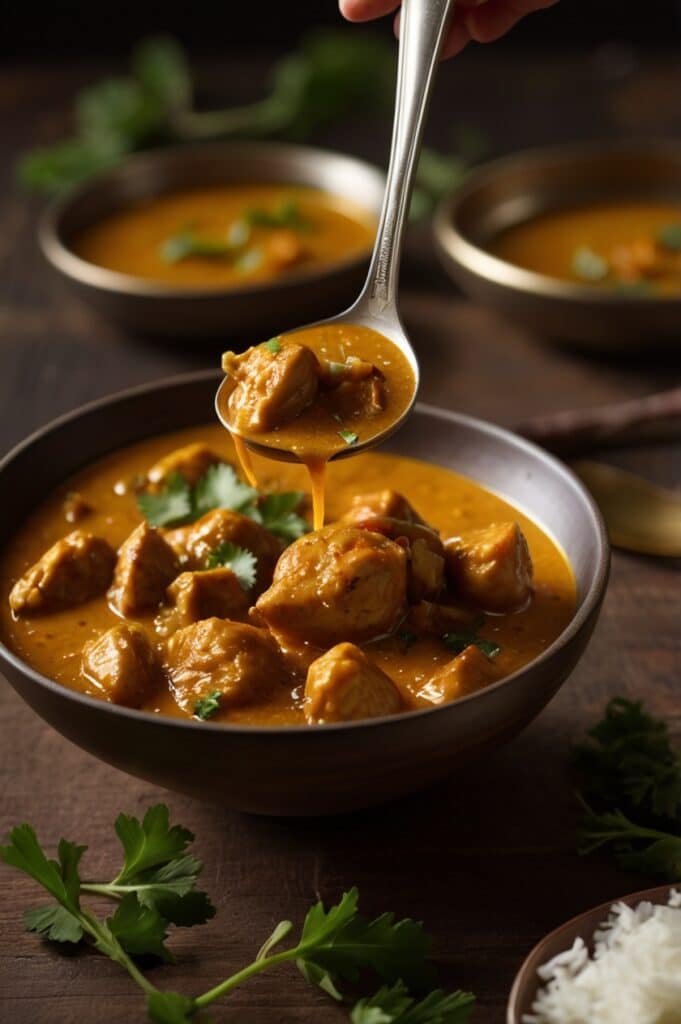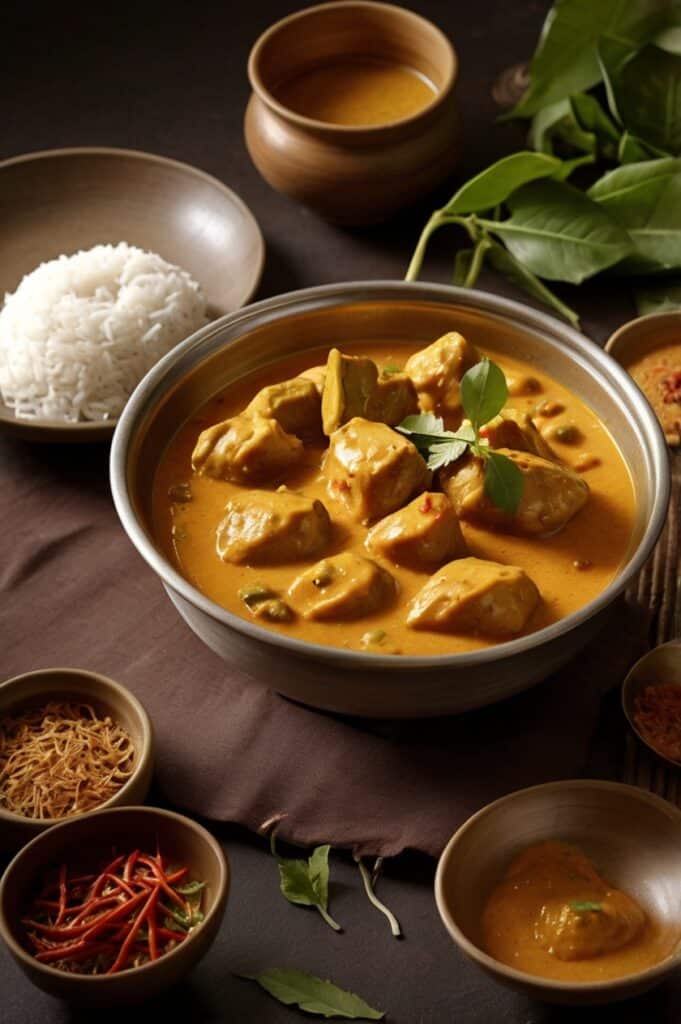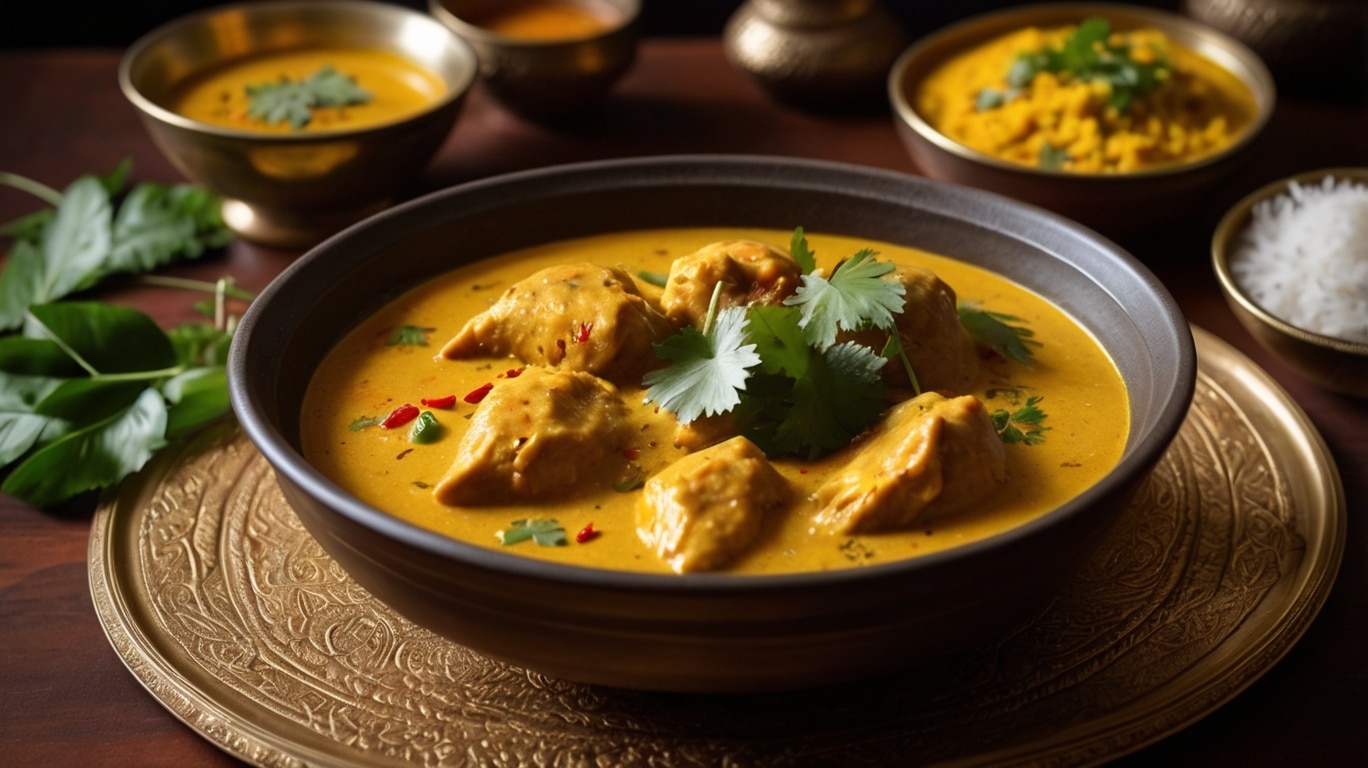I still remember the first time I tasted real Nadan Kozhi Curry in a sleepy village near Alappuzha. The chicken was simmered in coconut milk so rich, it almost coated your soul. The aroma? A full punch in the nose—sweet, spicy, earthy—all of it. And that flavor? Oh lord, it lingered. You don’t forget a curry like that. You chase it forever.
Authentic Kerala Coconut Chicken Curry is no ordinary chicken curry. It’s rooted in centuries of spice trade, coastal abundance, and generations of home cooks who don’t measure but know by smell. What makes this dish stand out is the holy trinity of coconut oil, curry leaves, and roasted spices. It’s fiery, fragrant, and deeply comforting. The slow simmer in coconut milk gives it a luscious texture that clings to rice like it was born for it.
Authentic Kerala Coconut Chicken Curry is not about shortcuts. It’s about layering—spices bloomed in oil, onions taken to the edge of caramelization, chicken cooked until tender enough to whisper apart. Each step matters. But hey, once you get the rhythm, it’s addictive.

Ingredients & Substitutions
Authentic Kerala Coconut Chicken Curry starts with good chicken—bone-in, skinless thighs or drumsticks are perfect. Breast meat dries up faster than gossip in a small town, so skip it unless you’re desperate.
- 1 kg chicken (bone-in thighs or drumsticks preferred)
- 3 tbsp coconut oil (extra virgin if possible)
- 1 tsp mustard seeds
- 2 sprigs curry leaves (fresh only—dried tastes like paper)
- 3 medium red onions, thinly sliced
- 1 tbsp ginger paste
- 1 tbsp garlic paste
- 3-4 green chilies, slit
- 1 ½ tsp turmeric powder
- 2 tsp red chili powder (adjust heat accordingly)
- 1 tbsp coriander powder
- 1 tsp garam masala
- Salt to taste
- 1 medium tomato, chopped
- 1 ½ cups thick coconut milk
- 1 cup thin coconut milk
- Fresh coriander leaves for garnish (optional)
Substitutions that actually work: You can use vegetable oil if you’re out of coconut oil, but expect flavor loss. No curry leaves? Add a bit more mustard seed and ginger, it’ll sort of fake it. For coconut milk, canned is okay—but mix thick and thin. Just using full-fat straight from the can? Your curry will split like a band on tour.
Why it matters: Fresh curry leaves pop and crackle in hot oil, infusing that fat with citrusy perfume. Coconut oil sets the stage—don’t replace it unless you must. And those red onions? They go sweet when cooked long enough. Don’t rush ’em, please.
Step-by-Step Instructions
Authentic Kerala Coconut Chicken Curry is all about patience and heat control. Don’t crank the flame and pray.
Step 1: Marinate the chicken.
Toss it with turmeric, salt, and a teaspoon of red chili powder. Let it sit for 30 mins or longer. Even an hour. This helps with flavor penetration. No need for yogurt or acid here—Kerala style don’t mess with that.
Step 2: Build the base.
Heat coconut oil in a heavy-bottomed pan. Add mustard seeds—wait till they dance and pop. Add curry leaves. They’ll crackle like fireworks. Toss in the onions. This is not a 5-minute job. Stir on medium heat until onions are golden-brown. Not burnt. Not soft. Golden. This takes 12–15 mins.
Step 3: Add the aromatics.
Ginger paste, garlic paste, green chilies—boom. The house will start smelling like a grandmother’s kitchen. Cook this for 2–3 mins till rawness is gone. Don’t skip or rush. This layer matters.
Step 4: Spice it right.
Lower the heat and add chili, coriander, turmeric. Stir fast. Dry spices burn in seconds. You’re not deep-frying ‘em. You’re blooming them. Add a splash of water if needed.
Step 5: Tomatoes go in.
Chop ’em rough. Stir into the pan till they break down and become jammy. Not watery. Not raw. Jammy. The masala should be thick now.
Step 6: Chicken in, mix well.
Coat every piece in that spiced-onion mixture. Sauté for 5–7 minutes. You’ll see the oils separating. That’s your cue.
Step 7: Add thin coconut milk.
Bring to a gentle boil. Cover and simmer for 20–25 mins till chicken is cooked through. Stir once or twice. Don’t fiddle too much.
Step 8: Thick coconut milk goes last.
Add it in, reduce heat to lowest. You don’t want it to split. Let it warm for 5–7 mins, no boiling. Finish with garam masala and a final toss of curry leaves.
Optional Step 9: Rest.
Like biryani, this curry gets better if it sits for a bit. Let it cool slightly. Reheat gently before serving.
Common Mistakes? Boiling thick coconut milk. Adding curry leaves at the end only. Not browning onions enough. Using boneless chicken breast (why though?).
Variations?
- For spicier versions, add more green chilies.
- Add cubed potatoes in step 6 for a one-pot meal.
- You can toss in a boiled egg or two for richness. Keralites do that a lot.

Cooking Techniques & Science
Authentic Kerala Coconut Chicken Curry uses tempering (aka “tadka”) as the backbone. When mustard seeds pop and curry leaves sizzle, they release volatile oils—think natural MSG. This technique perfumes the oil, which then carries the flavor through the whole dish.
The onion stage is caramelization, not softening.
This draws out natural sugars and gives body to the curry. Half-cooked onions leave a raw edge and wreck texture.
Why coconut milk splits:
Boiling coconut milk forces the fat to separate from water. Low heat keeps it together. That’s why it’s always added at the end, never the start.
Tool tip:
Heavy-bottomed pan or Dutch oven is a must. Thin pans scorch the spices and give you acrid bitterness. Also, a wooden spatula helps scrape up bits without wrecking the pan.
Cultural context:
This curry is a staple in Syrian Christian households and during Onam Sadya (feast). But you’ll find a version in every Kerala home. Some add peppercorns, some add fennel. No two families make it quite the same—and that’s what makes it alive.
Serving & Pairing Suggestions
Authentic Kerala Coconut Chicken Curry shines with Kerala-style matta rice. That pinkish, nutty rice? It’s not just pretty—it absorbs the curry like a sponge. Steamed white basmati also works if matta isn’t around.
Other great pairings:
- Ghee rice
- Appam (fermented rice pancakes with crispy lace edges)
- Malabar parotta (buttery, flaky flatbread)
- Thoran (dry coconut vegetable stir-fry) on the side for crunch
Presentation tip:
Use a banana leaf if you’re going full traditional. Top with a few fried curry leaves and a drizzle of coconut oil. Not olive oil. Not ghee. Coconut oil.
Drink pairings?
Buttermilk with ginger and green chili. Or even a crisp lager. The richness of the curry loves a little acidity or fizz to cut through it.
Conclusion
Authentic Kerala Coconut Chicken Curry isn’t a 15-minute miracle. It’s a journey. But every stage—from the first pop of mustard seeds to the last lick of curry off your fingers—pays off. The depth of flavor, the creamy spice, the warmth of it all? Worth it.
This is a dish that speaks of rain-soaked backwaters, sun-dried chilies, and stories passed down in iron pots. Master it, and it becomes your comfort food forever.
Got coconut milk? Got bone-in chicken? Then you’re halfway there already.
FAQs
Can I make Authentic Kerala Coconut Chicken Curry ahead of time?
Yes, in fact—it tastes better the next day. The flavors deepen and meld overnight. Just reheat gently and avoid boiling.
What if I only have canned coconut milk?
Use it, but mix ½ cup water with it to mimic thin coconut milk. Use undiluted for thick coconut milk at the end.
Can I use boneless chicken?
You can, but you’ll lose flavor. Bone-in cuts provide depth and natural umami. If using boneless, reduce cooking time slightly.
Is this curry very spicy?
It’s medium-hot by South Indian standards. Control the heat by adjusting chilies and chili powder. Add a splash of lime at the end to cool things off.
Can I freeze this curry?
Yes, but skip adding the thick coconut milk until reheating. That way, you avoid curdling. Freeze the cooked chicken curry base, thaw, and add coconut milk when warming up.

Olivia P. is a seasoned food blogger at Tastywink, sharing delicious, easy-to-follow recipes inspired by him passion for home cooking. With years of culinary blogging experience, he brings flavor, creativity, and a personal touch to every dish.
